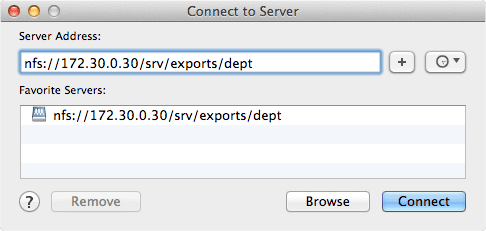
- #MAC NETWORK DRIVE NFS MOUNT USERNAME AND PASSWORD MAC OS X#
- #MAC NETWORK DRIVE NFS MOUNT USERNAME AND PASSWORD MAC OS#
- #MAC NETWORK DRIVE NFS MOUNT USERNAME AND PASSWORD MANUAL#
- #MAC NETWORK DRIVE NFS MOUNT USERNAME AND PASSWORD WINDOWS 10#
Here you can pass some extra parameters to the NFS mount. Expand the Advanced Mount Parameters section. For the local mount location, use something like /nfs/fileserver.ĥ. For the remote NFS URL, use nfs:/// for example: nfs:///srv.Ĥ. Select the “+” button at the bottom left of the window to add a new NFS mount.ģ. A new window will open that lists any defined NFS mounts.Ģ. In the menu bar, select File | NFS Mounts. It is easier to configure, but becomes painful if there are a lot of NFS mounts to set up, as you must do them one by one.ġ. Instead, use the Disk Utility GUI to set up individual NFS mounts. This uses the automountd daemon which is configured using the /etc/nf and /etc/auto_master configuration files.įor those familiar with UNIX, or in environments with a lot of regularly-accessed NFS mounts, it would be worth exploring setting up NFS mounts this way, but I have found it to be quite frustrating. The first is to use the built-in automount setup, which allows you to automatically connect to hosts by accessing /net//, but this can be problematic. With OS X 10.6, there are two ways to have your Mac set up as an NFS client. For sharing files with Linux or other UNIX servers, using NFS is a great solution, but getting OS X set up as an NFS client can take a little trial and error. For interoperation with Windows, SMB is best. For Mac-to-Mac file sharing, AFP is the best solution. It supports AFP, SMB, FTP, and NFS out of the box.
#MAC NETWORK DRIVE NFS MOUNT USERNAME AND PASSWORD MAC OS#
Mac OS X, being a UNIX-based operating system, can handle a number of file sharing protocols.
#MAC NETWORK DRIVE NFS MOUNT USERNAME AND PASSWORD MAC OS X#
#MAC NETWORK DRIVE NFS MOUNT USERNAME AND PASSWORD WINDOWS 10#
The domain option might be optional but the default Windows 10 workgroup is WORKGROUP so this should work as long as you didn't change it.

Password=the_qnap_user_password_you_chose Username=your_shared_linx_and_qnap_username

I was having trouble mounting my QNAP NAS Samba share on Ubuntu 18.04 with a credentials file. So, what am I doing wrong? Any help would be much appreciated. It appears that the password is being concatenated onto the IP of the server. man mount.cifs)ġ68.1.10 is the partial IP address of the server on which the shares that I want to mount are located.
#MAC NETWORK DRIVE NFS MOUNT USERNAME AND PASSWORD MANUAL#
Refer to the mount.cifs(8) manual page (e.g. sudo mount -a -v outputs the following: / : ignored smbcredentials containing the following: user=username However, if I try this: //server/share /mount/point cifs ro,auto,credentials=/etc/.smbcredentials 0 0 So this: //server/share /mount/point cifs ro,auto,user=user,password=password 0 0 However, when I try to use a “credentials” file, it all goes pear-shaped. If I put the username and password into each line of fstab and do sudo mount -a, it works fine.

I’m trying to mount a number of Windows Server network shares. I’m having a problem with fstab on Server 18.04.


 0 kommentar(er)
0 kommentar(er)
